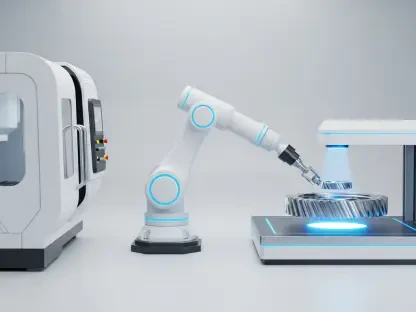Industrial automation has seen tremendous advancements, thanks to the introduction of Variable Frequency Drives (VFDs). These devices have become indispensable in modern industries, driving everything from basic conveyors to advanced robotic systems. A significant leap in this technology is the implementation of master-follower configurations, ensuring seamless synchronized motion across multiple axes. As industries strive for higher efficiency and precision, understanding how master-follower configurations contribute to industrial automation becomes crucial.
To comprehend the critical role of master-follower configurations, one must first understand the distinction between single-axis and multi-axis applications. Single-axis applications involve simple setups where each drive operates independently. This setup is commonly used in scenarios where synchronized motion is neither necessary nor advantageous. Conversely, multi-axis applications demand intricate coordination between multiple drives, which is where master-follower configurations come into play. These configurations are vital for complex tasks that require several drives to work in harmony, ensuring precise motion and load distribution.
Single-Axis vs. Multi-Axis Applications
In single-axis applications, each drive functions autonomously, making the system straightforward and reliable. A typical example is a pump motor application, where a single motor can perform the necessary operations without requiring integration with other drives. Such scenarios are frequent in industries where tasks do not involve synchronized motion. The simplicity of single-axis setups offers ease of maintenance and operation, making them suitable for less complex industrial processes.
Multi-axis applications, however, present a different set of challenges and opportunities. In these setups, multiple drives must operate cohesively to achieve desired outcomes. This necessity arises in processes like conveyor belt systems, where the synchronized motion of various belts ensures a smooth flow of products. Without proper synchronization, product mishandling and operational inefficiencies can occur. The intricate coordination required in multi-axis applications underscores the importance of master-follower configurations.
Master-follower arrangements necessitate a deeper understanding of synchronized motion and the technologies that enable it. Essentially, a master drive dictates the movement of one or more follower drives, ensuring they operate in unison. This coordinated effort is indispensable for tasks like material handling, where the precise alignment of movements is critical for operational success. With master-follower configurations, industries can achieve higher efficiency, reduced operational costs, and enhanced product quality.
Understanding Master-Follower Configuration
A master-follower configuration allows for synchronized motion by having a master drive control the operation of follower drives. This arrangement is essential in applications where precise movement coordination is crucial. For instance, in material handling systems or mechanical linkages, synchronized motion ensures seamless operation and high precision. The master drive sends signals to follower drives, instructing them on movement speed and position, thus maintaining uniformity across all drives involved.
One of the standout features of master-follower configurations is their software flexibility. Adjustments to gear ratios, speed, and movement direction can be made effortlessly via software without needing physical modifications to the hardware. This capability not only saves time but also cuts down on operational costs. By eliminating the need for mechanical adjustments, industries can adapt more rapidly to changing requirements, enhancing their overall efficiency and flexibility.
Another significant advantage of master-follower systems is their scalability. As industrial processes evolve, the ability to add, replace, or relocate follower motors with minimal redesign efforts proves invaluable. This scalability ensures that industries can expand or modify their operations without incurring substantial overhaul costs. The system’s adaptability to varying industrial needs underscores its significance in modern automation practices.
Advantages of Master-Follower Systems
Apart from software flexibility, master-follower systems bring a multitude of benefits to industrial automation. One of the major advantages is the effective distribution of load among multiple motors. This load distribution enhances system resilience and mitigates the risk of overloading any single motor. Should one motor experience an issue, the others can compensate, ensuring the system continues to operate smoothly. This redundancy enhances overall reliability and reduces the risk of operational downtimes.
Moreover, master-follower configurations can significantly reduce the load on Programmable Logic Controllers (PLCs). Instead of relying heavily on PLCs for synchronization, these configurations enable direct drive-to-drive communication. This shift simplifies the development process and lowers operational costs, making it easier for industries to implement and maintain automated systems. By offloading synchronization tasks from PLCs, businesses can focus on optimizing other aspects of their operations.
Another advantage is the reduction in mechanical wear and tear. By ensuring smooth and synchronized operations, master-follower configurations reduce the mechanical stress on individual components. This reduction extends the lifespan of machinery and lowers maintenance costs. The direct communication between drives ensures faster response times and precise control, which are critical in high-speed industrial applications.
High-Speed Synchronization with Encoder Signals
Achieving high-speed synchronization is paramount for minimizing following errors in master-follower systems, and encoder signals play a crucial role here. These signals, processed in microseconds, ensure that the setpoints from the master drive are transmitted quickly and accurately to follower drives. This rapid data transfer ensures real-time synchronization, which is essential for maintaining the precision required in sophisticated industrial applications. The timely and accurate transmission of signals helps reduce discrepancies and following errors, leading to smoother and more reliable operations.
Incorporating incremental encoder emulation further enhances high-speed synchronization. Technologies such as KEB’s S6 and F6 drives exemplify the practical implementation of these configurations. These drives support incremental encoder signals, ensuring that data is transferred at high speeds for precise control. The use of encoder emulation oversees the synchronization process, maintaining uniform motion across all drives involved. This technological advancement underscores the role of VFDs in modernizing industrial operations.
The importance of high-speed synchronization extends beyond just operational accuracy. It also plays a crucial role in improving overall system efficiency. Accurate synchronization ensures that each drive performs its task at the right time and speed, eliminating bottlenecks and enhancing workflow. This improvement is particularly beneficial in high-speed production environments, where any delay or error in synchronization can lead to significant productivity losses.
Methods of Synchronization
Master-follower configurations employ various synchronization methods to ensure operational accuracy. One common method is speed synchronization, which aligns the speeds of all drives involved. This method is relatively straightforward but may accumulate errors over time, making it most suitable for applications where consistent speed is essential but not critical. In such scenarios, speed synchronization ensures that all drives operate at the same pace, preventing discrepancies that could disrupt the process.
For applications requiring more precise positional alignment, angular synchronization offers a more complex yet effective solution. This method involves correcting positional discrepancies between drives, ensuring they move in perfect harmony. Angular synchronization is ideal for tasks like winders or theater stage setups, where exact movement synchronization is crucial. By constantly adjusting the position of each drive, angular synchronization maintains the desired alignment, preventing errors that could compromise the operation.
The choice between speed and angular synchronization depends on the specific requirements of the industrial application. While speed synchronization is simpler and easier to implement, it may not provide the precision needed for more complex tasks. Angular synchronization, though more intricate, ensures higher accuracy and is better suited for applications where positional alignment is critical. Understanding the strengths and limitations of each method allows industries to choose the most appropriate synchronization technique for their needs.
Practical Industrial Applications
Achieving high-speed synchronization is crucial for minimizing following errors in master-follower systems. Encoder signals, which are processed in microseconds, ensure that setpoints from the master drive are transmitted quickly and accurately to follower drives. This rapid data transfer enables real-time synchronization, vital for maintaining the precision required in sophisticated industrial applications. Timely and accurate transmission of signals reduces discrepancies and following errors, leading to smoother and more reliable operations.
Incorporating incremental encoder emulation further enhances high-speed synchronization. Technologies such as KEB’s S6 and F6 drives exemplify the practical implementation of these configurations. These drives support incremental encoder signals, ensuring that data is transferred quickly for precise control. Encoder emulation helps oversee the synchronization process, maintaining uniform motion across all drives involved. This technological advancement highlights the role of Variable Frequency Drives (VFDs) in modernizing industrial operations.
The importance of high-speed synchronization goes beyond operational accuracy. It significantly improves overall system efficiency. Accurate synchronization ensures that each drive performs its task at the right time and speed, eliminating bottlenecks and enhancing workflow. This improvement is particularly advantageous in high-speed production environments, where any delay or error in synchronization can lead to significant productivity losses. High-speed synchronization thus plays a pivotal role not only in accuracy but also in boosting productivity and efficiency in industrial settings.









